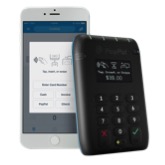PayPal Here Chip Card Reader Makes US Debut

Staying ahead of the payments curve isn’t easy in the fast-paced payments market, but PayPal is rolling out its latest product to ensure SMBs can do their part to stay up to date.
Nearly two years after launching the device in the U.K. and Australia, PayPal has officially rolled out the PayPal Here Chip Card Reader, which will be ready to buy Sept. 30.
 The reader, which is compatible with iOS and Android devices, accepts chip cards (both EMV chip-and-PIN and EMV chip-and-signature), magnetic stripe and NFC transactions, including Apple Pay, Android Pay and Samsung Pay, along with other NFC-enabled devices and cards.
The reader, which is compatible with iOS and Android devices, accepts chip cards (both EMV chip-and-PIN and EMV chip-and-signature), magnetic stripe and NFC transactions, including Apple Pay, Android Pay and Samsung Pay, along with other NFC-enabled devices and cards.
With the Oct. 1 EMV merchant liability shift just three days away, PayPal has also continued to push its educational materials toward merchants to remind them the importance of being EMV-certified.
“It is important that merchants understand the consequences of the EMV liability shift of fraud losses. To help our small business customers prepare, we have been providing updates on the process since earlier this year and educating businesses on what the liability shift means for them,” Brad Brodigan, vice president and general manager of retail for PayPal, wrote in a blog post today (Sept. 28).
As that liability shift goes into effect, merchants should look at the switch as a chance to modernize their point-of-sale systems, he said, which also allows them to sell online, on mobile and in person. And it does so using one device and from the same account.
“We found that a lot of merchants are confused; they don’t have a level of awareness. Our efforts have been not only to help them understand what the fraud liability is, but also what the benefits are of going through an EMV certification process. We don’t think enough merchants are aware of the benefits that they can have related to this type of change. We’ve been talking to merchants about things like their ability to actually lower their expenses through lower fraud rates. Also, in addition to that, there’s a tremendous amount of opportunity for merchants as they go through this externalization to lower their costs for point-of-sale hardware and software,” Brodigan said.
He also pointed toward the cost benefits.
“Some of the new solutions out there can run on much less expensive hardware and tablet devices. These cloud-based software solutions can be far less expenses, including in some cases free. So merchants have tremendous opportunities to lower their expense. But with these new solutions come advanced capabilities: things like advanced CRM solutions, customer engagement tools and the ability to accept new forms of payments — like mobile payments,” Brodigan added.
While chip-and-PIN is the common form factor in the U.K. and Australia, he said in the U.S., “the jury is still out. Because of that mix, PayPal decided it’s important to provide merchants with a future-proofed solution to avoid having to purchase multiple devices to collect different forms of payments. That means providing them with one device that can process all types of payments.”
In terms of getting merchants onboarded quicker and getting them EMV-compliant, Brodigan also explained how the PayPal Here reader achieves that goal, too. The price of the device is its first seller since it sells for $149. But for merchants that process just $3,000 in three months from activating the chip card reader, PayPal will give them a $100 rebate — making the final cost of the device $49.
“Merchants want something that’s simple and easy because they really don’t understand it. The beauty of this device is in one package you have a point-of-sale payment terminal, point-of-sale software, as well as processing, all in one easy-to-use bundle. A lot of small businesses realize that this is a smaller and easier way for them to actually become EMV-certified,” he said, later pointing toward PayPal’s niche in the card reader market for SMBs.
“From our perspective, we’re a digital payment platform that operates not only on our PayPal Here software but also integrate with other providers like Vend and others so that we give merchants choice and options so that they can process payments with the hardware, software and processor that they elect,” Brodigan said.
To check out what else is HOT in the world of payments, click here.
